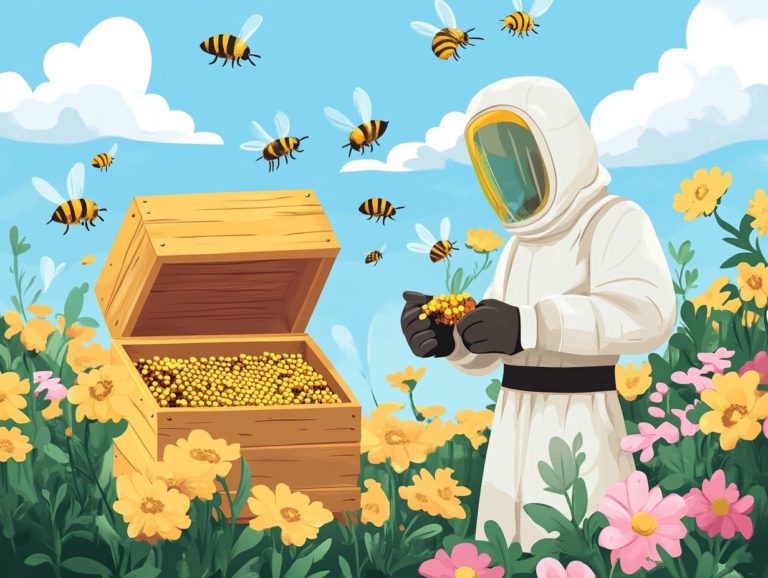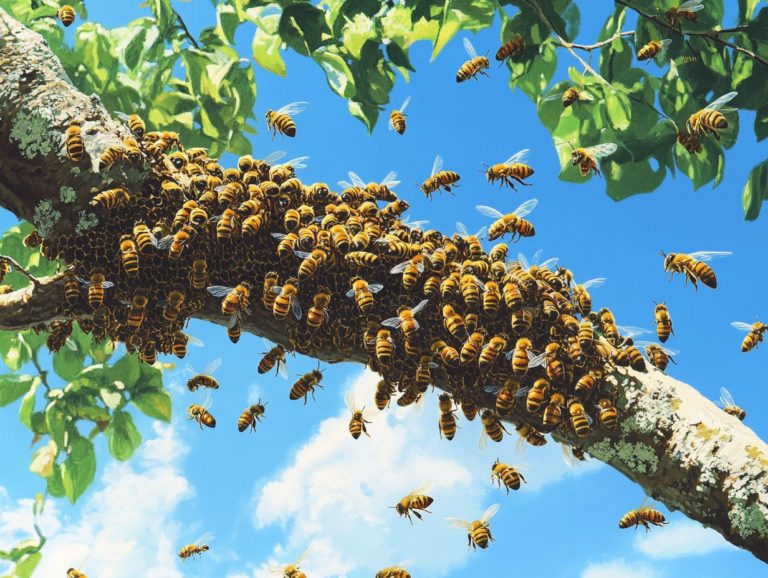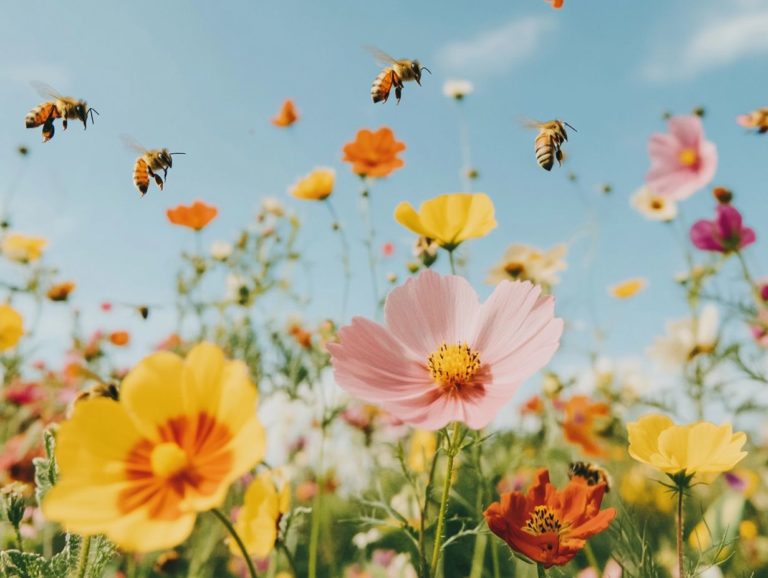The Role of Bees in Food Production
Bees are often underestimated, yet they play a crucial role in your food production and the health of our ecosystems. These remarkable pollinators, including honey bees and other bee species, are responsible for the reproduction of many flowering plants that yield the fruits, vegetables, and nuts you rely on daily.
However, bee populations are facing serious threats, from pesticide use to climate change. This article explores different types of bees, their pivotal role in pollination and crop production, the challenges they encounter, and what you can do to protect these vital creatures for future food security and healthy foods. Let s discover how bees are vital for our food and how we can help protect them!
Join in as you uncover the importance of bees in sustaining your environment and global food systems.
Contents
- Key Takeaways:
- The Importance of Bees in Food Production and Agriculture
- What Are Bees and Their Role in Food Production?
- Why Are Bees Essential for a Healthy Ecosystem and Biodiversity?
- What Are the Threats to Bee Populations?
- What Can We Do to Protect Bees and Ensure Food Production?
- How Can We Ensure Sustainable Food Production Without Bees?
- Frequently Asked Questions
- What role do pollinators like the honeybee play in agriculture?
- What is the role of bees in food production?
- How do bees contribute to food production?
- What types of foods are dependent on bee pollination?
- Why are bees important for sustainable food production?
- What are the consequences of declining bee populations?
- What can I do to help protect bees and support food production?
Key Takeaways:
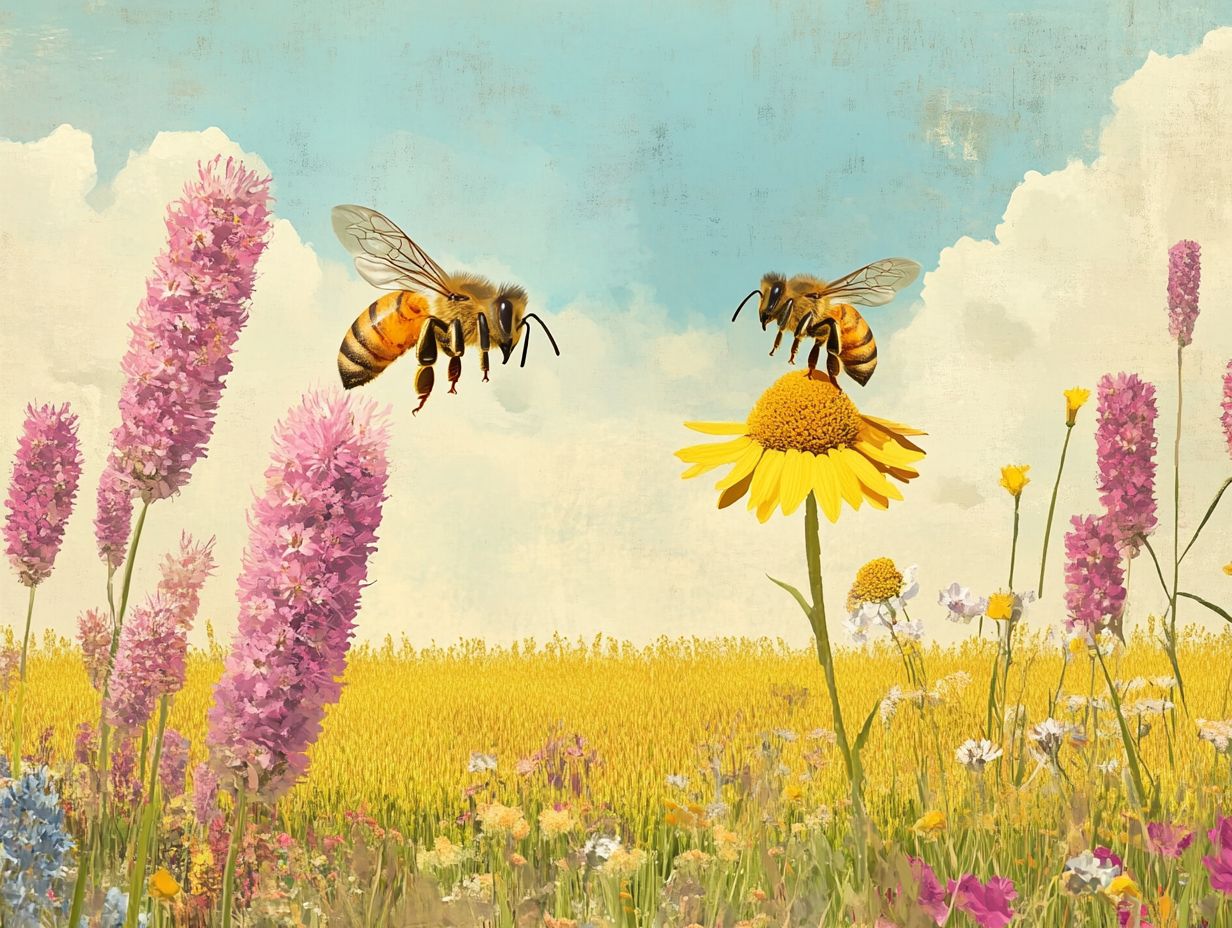
- Bees play a crucial role in food production as they are responsible for pollinating many crops, including almond trees, and ensuring their growth and reproduction.
- Bees are essential for a healthy ecosystem as they not only contribute to food production but also help maintain plant diversity and support other wildlife, thereby enhancing biodiversity.
- The decline of bee populations is a significant threat to food production. We can protect them by promoting bee-friendly practices and educating others about their importance.
The Importance of Bees in Food Production and Agriculture
Bees are essential to food production, serving as the primary pollinators for many flowering plants that are vital for agriculture. Honey bees, especially species like Apis mellifera, are responsible for pollinating a substantial portion of the crops you rely on, including almonds, fruits, and vegetables.
Their hard work not only boosts crop yields and enhances fruit quality, but also plays a critical role in maintaining the overall health of the global food system, safeguarding food security and access to nutritious options. The Food and Agriculture Organization of the United Nations emphasizes the importance of pollinators in sustaining agricultural productivity.
The decline in bee populations presents significant threats to biodiversity and ecological interactions, underscoring the importance of understanding their role in our ecosystem. Experts like Barbara Gemmill-Herren and Peter Kofi Kwapong stress the urgent need for conservation efforts to protect these vital pollinators.
What Are Bees and Their Role in Food Production?
Bees, especially honey bees like Apis mellifera, play a crucial role as pollinators, making them essential to food production. These remarkable insects help transfer pollen from the male to the female parts of flowers, leading to fertilization and the eventual production of fruits and seeds.
By engaging in this vital process, they significantly impact crop yield, quality, and the overall health of our food systems. Understanding their essential contribution will help us protect our future food supply!
What Are the Different Types of Bees?
There are various types of bees out there, and while honey bees tend to steal the spotlight, countless other bee species also play pivotal roles as pollinators. You ll find bumblebees, solitary bees, and mason bees, each one contributing uniquely to the rich tapestry of ecosystems and the pollination of a diverse array of crops. Grasping the diversity of bee species is essential for effective conservation efforts and sustainable agricultural practices. In regions like Kenya, Ghana, Costa Rica, and Brazil, native bee species are crucial for local agriculture.
Take bumblebees, for example. They thrive in cooler climates and are champions of buzz pollination, making them essential for plants like tomatoes and blueberries. Then there are solitary bees, such as leafcutter bees, which excel in foraging and nesting, often tending to crops that need a little more specialized attention. Mason bees are your early-season overachievers, capable of significantly boosting fruit yields. In Italy, for instance, mason bees are widely used to improve the yields of various fruit crops.
Losing any of these bee species isn t just a setback for food production; it shakes the very foundations of the intricate web of life that maintains ecological balance. This underscores their irreplaceable value in both agriculture and biodiversity, making it all the more critical to appreciate and protect these remarkable pollinators.
How Do Bees Help with Pollination?
Bees play an essential role in the pollination process, a critical component for the reproduction of many flowering plants and agricultural crops. This relationship between bees and flowering plants exemplifies mutualism: bees obtain nourishment from nectar and pollen while simultaneously ensuring the reproductive success of the plants. Environmental factors such as temperature and floral resource availability significantly influence this delicate balance.
It’s important to recognize that environmental factors, such as temperature and the availability of floral resources, significantly influence how effectively bees perform their pollination duties.
These remarkable insects embark on intricate journeys from flower to flower, collecting pollen and nectar to sustain their colonies. This pollen transfer is crucial for fertilizing plants, enabling them to produce seeds and fruit. Consider crops like almonds, blueberries, and apples all of which depend heavily on bee pollination for a prosperous harvest. Moreover, a wide range of wildflowers also relies on these diligent pollinators, showcasing the interconnectedness of ecosystems.
When conditions are just right, particularly on warm, sunny days, bees become highly active, enhancing their efficiency in transferring pollen and directly influencing agricultural productivity.
Why Are Bees Essential for a Healthy Ecosystem and Biodiversity?
Bees play an essential role in maintaining a healthy ecosystem, serving as vital pollinators that support biodiversity and foster ecological interactions among numerous species. Their presence significantly enhances the stability and resilience of ecosystems, encouraging the growth of a diverse array of flowering plants that offer habitats and nourishment for other wildlife.
By fulfilling their role as pollinators, bees help create a balanced environment capable of sustaining essential ecological processes and supporting our food systems.
What Are the Threats to Bee Populations?

Bee populations are encountering a multitude of threats that pose significant risks to biodiversity and food production, largely as a result of human activities and environmental changes. Pesticides, habitat loss, and climate change stand out as major contributors to the decline of various bee species.
The repercussions of these threats extend beyond the survival of bees; they also endanger the essential pollination services these insects provide, which are vital for both agricultural and natural ecosystems.
1. Pesticides and Chemicals
Pesticides and chemicals used in agriculture pose significant threats to bee populations, impacting their health, behavior, and survival rates. When bees are exposed to neonicotinoids and other harmful substances, they can become disoriented, forage less efficiently, and even face death. These outcomes directly affect the crucial pollination services they provide.
Different types of pesticides can affect bee species differently. Some may be particularly harmful to honeybees, while others can significantly endanger native wild bee populations. Regulatory measures, including stricter pesticide application guidelines, are essential for safeguarding these vital insects.
By adopting sustainable farming practices, such as integrated pest management (a method that combines different ways to control pests), organic farming, and crop rotation, you can greatly reduce reliance on harmful chemicals. Promoting these approaches not only helps protect pollinator health but also contributes to the resilience of entire ecosystems.
In doing so, you create a harmonious balance where both agriculture and wildlife can thrive together. Experts like Tim Brod and Dan Janzen advocate for these sustainable practices to protect pollinators and ensure food production stability.
2. Habitat Loss
Habitat loss resulting from urbanization, agricultural expansion, and land-use changes has taken a significant toll on bee populations and their ability to flourish. As natural habitats give way to monoculture farming or urban developments, bees find themselves deprived of the diverse flowering plants essential for their nutrition and nesting.
This shift leads to alarming declines in their populations and a loss of biodiversity. The repercussions of this loss ripple through entire ecosystems and agricultural productivity.
Bees, as vital pollinators, play an essential role in sustaining plant communities and enhancing crop yields. Recognizing this sobering reality highlights the urgent need for effective conservation strategies to mitigate these adverse impacts.
You can take essential steps toward rejuvenating habitats by implementing practices such as:
- Creating urban green spaces: These areas can provide essential habitats for bees.
- Restoring native plant communities: Native plants are crucial for feeding and sheltering local bee populations.
- Adopting pollinator-friendly agricultural methods: These methods boost biodiversity and support bee health.
Educating communities about the importance of supporting local bee populations through native plant gardens can provide critical resources that aid in foraging and nesting. This enables these crucial creatures to recover and thrive once again. In countries like Costa Rica and Brazil, community-driven initiatives have been successful in preserving native bee species and enhancing local biodiversity.
3. Climate Change
Climate change presents a substantial threat to bee populations, impacting their life cycles, foraging behaviors, and the seasonal availability of flowering plants. As temperatures and weather patterns shift, the delicate timing between bees and the blooming of plants can become disrupted. This leads to mismatches that jeopardize both bee survival and agricultural productivity.
The effects of climate change on bee populations are particularly evident in regions like California, where shifts in climate patterns have already impacted almond pollination cycles. This disruption not only affects bees, including the honeybee (Apis mellifera), but has far-reaching consequences for the ecosystems that depend on these vital pollinators.
A decline in bee activity can lead to lower crop yields and a decrease in biodiversity, putting food security and the stability of natural habitats at risk. For instance, the almond industry in California relies heavily on these pollinators.
Without effective mitigation strategies such as habitat restoration, sustainable agricultural practices, and a reduction in greenhouse gas emissions the long-term ramifications of these changes could be severe. It s imperative for communities, farmers, and policymakers to collaborate in creating environments that support resilient bee populations.
By taking action now whether it be planting bee-friendly flowers or advocating for local conservation efforts you can help ensure a balanced ecosystem and sustainable food production for generations to come.
What Can We Do to Protect Bees and Ensure Food Production?
To safeguard bees and promote sustainable food production, you and your community can implement a variety of proactive measures. Create bee-friendly gardens and support local beekeepers. Engaging with local experts like Tim Brod can provide valuable insights into best practices.
Choose plants that provide plenty of nectar and pollen. Avoid harmful pesticides to help bees thrive. These thoughtful actions not only contribute to the well-being of bee populations but also bolster local agriculture and enhance food security for everyone involved. This is particularly important in countries like Kenya, Italy, and Ghana.
1. Plant Bee-Friendly Gardens
Creating a bee-friendly garden is one of the most impactful ways you can support and protect bee populations. These gardens serve as crucial havens, offering essential resources like nectar and pollen from a diverse array of flowering plants. By incorporating native plants and a variety of species, you can attract different types of bees and enhance overall biodiversity.
To elevate your garden, consider adding plants such as:
- coneflowers
- black-eyed Susans
- milkweeds
These favorites are particularly sought after by bees for their abundant nectar. Don’t overlook certain herbs like lavender and thyme, which provide nourishment for bees and infuse your garden with delightful fragrances.
As you design your bee-friendly space, aim for an array of bloom times. Ensure flowers are available from early spring to late fall. Group similar plant species together to simplify foraging for bees, while maintaining chemical-free gardening practices to create a sanctuary for these essential pollinators.
Act now to create a bee-friendly garden and protect our vital pollinators!
2. Avoid Using Harmful Pesticides

Avoiding harmful pesticides is essential for safeguarding bee populations, as these chemicals can have devastating effects on their health and survival. By choosing organic farming practices and smart pest control methods, you can create safer environments for bees while ensuring healthy crop production.
These methods also include alternative pest control techniques like companion planting, which can significantly enhance the ecological balance in your gardens and farms. Certain plants naturally repel pests, reducing your reliance on chemical interventions while also providing a food source for beneficial insects.
Biological pest control, which means using natural predators like ladybugs to manage pest populations, is another effective strategy. This method protects bees and other crucial pollinators. Raising community awareness about the importance of reducing pesticide use can lead to greater advocacy for bee-friendly practices and foster a culture of stewardship that benefits both agriculture and the environment.
Join the movement today to protect our bees!
3. Support Local Beekeepers
Supporting local beekeepers is essential for ensuring the sustainability of bee populations and the honey industry, both of which are crucial for food security. When you purchase honey and other bee products from nearby beekeepers, you actively promote practices that prioritize bee health and biodiversity.
Moreover, buying from local beekeepers invigorates local economies by keeping your dollars circulating within the community. This connection creates jobs and fosters a deeper understanding of agricultural practices among residents. By engaging with beekeepers through farmers’ markets, farm tours, and educational workshops, you have the opportunity to build personal relationships with these vital stewards of pollination.
When you participate in local conservation initiatives, you play an active role in protecting bees and their habitats. This enhances environmental awareness and fosters a collective commitment to sustainability. Researchers like Peter Kofi Kwapong and Winne Hallwachs have shown the significant impact of such activities in countries like Costa Rica and Brazil.
Take action now to support local beekeepers and strengthen our food systems!
In conclusion, protecting bees is essential for our ecosystems and food production. By implementing these practices, we can secure a brighter future for both local ecosystems and economies. Together, we can make a difference!
4. Educate Others about the Importance of Bees
Educating others about the importance of bees is crucial for fostering awareness and promoting conservation efforts to safeguard these vital pollinators. By sharing insights into the ecological and agricultural significance of bees, you can inspire collective action that creates bee-friendly environments and supports biodiversity.
Workshops and community events serve as powerful platforms for this education, allowing participants to engage directly with experts and experience firsthand how bees contribute to our ecosystems. Developing accessible educational resources, such as pamphlets and online content, can expand your outreach, inviting diverse audiences from schools to local businesses to discover the vital role bees play in food production and environmental health.
Ultimately, enhancing understanding of these pollinators is essential for cultivating a shared commitment to conservation. This ensures that future generations not only appreciate but also advocate for the protection of bee populations.
How Can We Ensure Sustainable Food Production Without Bees?
Ensuring sustainable food production without bees presents considerable challenges, given their important role in helping plants grow. However, you can explore alternative methods to maintain crop yields.
Techniques like hand pollination, using alternative pollinators, and implementing crop rotation and diversity can effectively mitigate the impact of declining bee populations and sustain your agricultural practices.
1. Alternative Pollinators
Utilizing alternative pollinators, such as bumblebees and solitary bees, is a promising strategy for maintaining food production without honey bees. This approach is already being explored in regions like California to supplement almond pollination.
These alternative pollinators effectively pollinate a wide variety of crops and are often less vulnerable to the threats faced by honey bees. This not only enhances biodiversity but also strengthens ecological interactions.
In many agricultural settings, these pollinators significantly improve the quality of fruits and seeds, yielding economic benefits for farmers. Crops like blueberries, tomatoes, and peppers often produce better yields with these resilient pollinators.
Their role in sustaining the health of ecosystem services is paramount. By promoting plant diversity, they create healthier habitats that can support a range of wildlife. Therefore, we must protect these pollinators now to ensure a sustainable future for our food systems!
2. Hand Pollination Techniques
Hand pollination techniques are becoming essential for those seeking to secure food production amidst the decline of natural pollinators like bees. Experts like Dan Janzen have studied this technique extensively.
This practice means carefully moving pollen from the male parts of flowers to the female parts, ensuring successful fertilization and fruit development especially for crops that depend heavily on these industrious pollinators.
You ll find various hand pollination methods, such as using brushes, cotton swabs, or even air blowers. Each method has different levels of effectiveness depending on the crop. For instance, fruits like tomatoes and cucumbers often thrive from this labor-intensive approach, particularly in controlled environments like greenhouses.
While the initial labor and costs may exceed those of relying on natural pollination, hand pollination presents a sustainable alternative that helps mitigate the risks tied to the decline of pollinators. This strategy not only has the potential to safeguard yield levels but also gives you greater control over the pollination process an essential factor in ensuring consistent quality and quantity in your produce.
3. Crop Rotation and Diversity
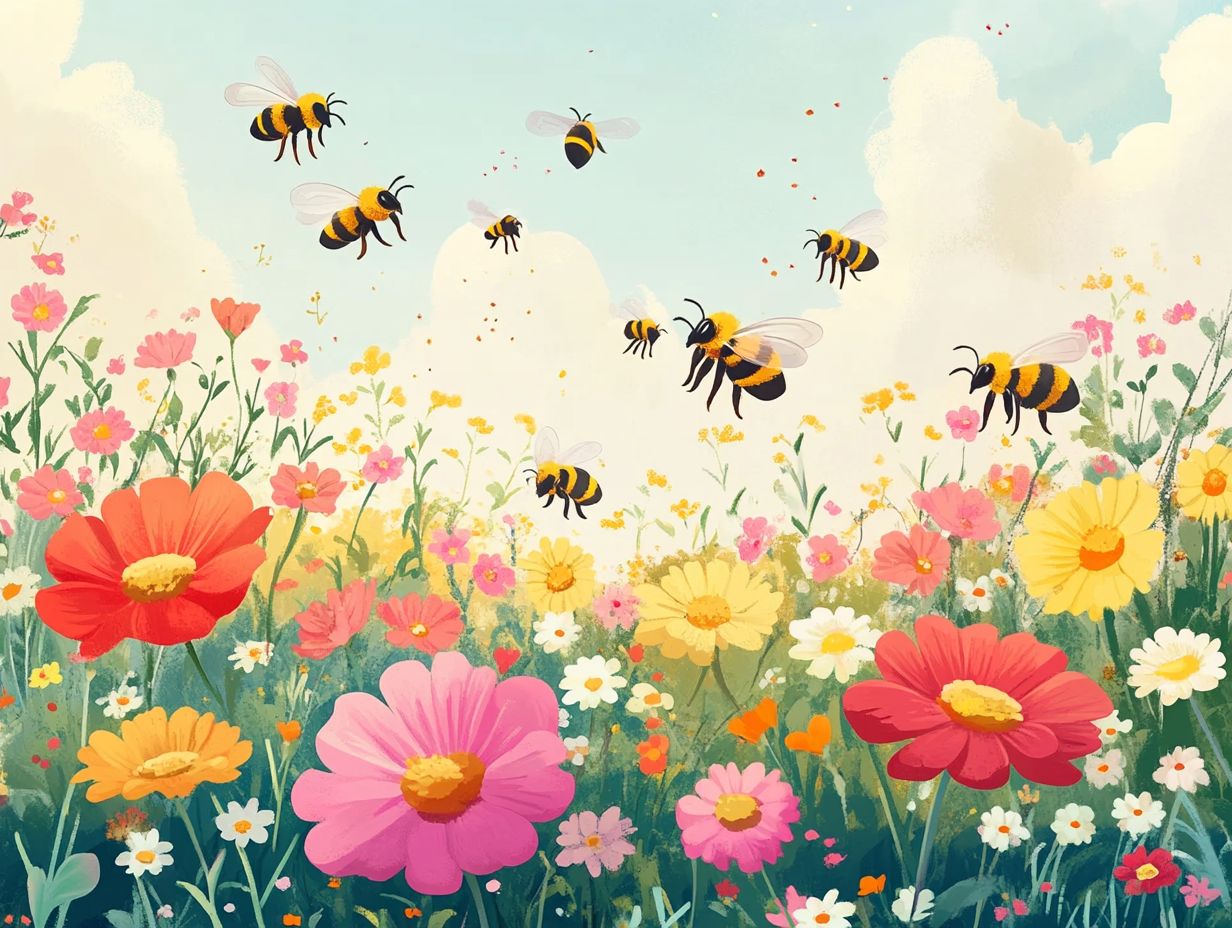
Implementing crop rotation and diversity is essential for sustainable food production and can help mitigate the loss of pollinators like bees. By alternating the types of crops you grow in a specific area, you can enhance soil health, reduce pest pressures, and cultivate a more resilient ecosystem that supports various pollinators and promotes healthy food production.
This technique aids in replenishing essential nutrients in the soil and disrupts the life cycles of pests and diseases that thrive when the same crop is planted repeatedly. For instance, when you rotate legumes with cereal grains, you enrich the soil with nitrogen, a vital nutrient that bolsters the growth of subsequent crops. Supported by the Food and Agriculture Organization of the United Nations, this practice is crucial for maintaining healthy crops.
Diverse plantings can attract beneficial insects, fostering a balanced ecosystem that reduces reliance on chemical interventions.
Consider the practice of intercropping corn with beans and squash, known as the Three Sisters. This method has demonstrated remarkable results in terms of yield and resilience. These practices significantly contribute to sustainable agriculture by enhancing soil health and increasing biodiversity, ensuring a productive farming future for both you and the environment. Experts like Barbara Gemmill-Herren and Peter Kofi Kwapong have highlighted the benefits of these agricultural techniques.
Frequently Asked Questions
What role do pollinators like the honeybee play in agriculture?
Pollinators such as the honeybee (Apis mellifera) are crucial for the pollination of many crops, ensuring the reproduction and yield of plants vital for agricultural productivity.
What is the role of bees in food production?
Bees are vital for pollination, essential for producing many fruits, vegetables, and crops. The importance of bees in agriculture has been documented by the Food and Agriculture Organization of the United Nations.
How do bees contribute to food production?
Bees pollinate flowers and crops, transferring pollen between plants, allowing them to reproduce and produce fruits and seeds. This results in a diverse and abundant supply of foods.
What types of foods are dependent on bee pollination?
Many foods we rely on for nutrition and taste, such as apples, almonds, blueberries, and broccoli, depend on bee pollination. In fact, one out of every three bites of food we eat is thanks to bee pollination. The contribution of pollinators like the honeybee (Apis mellifera) to our food supply cannot be overstated.
Why are bees important for sustainable food production?
Notable advocates for bee conservation include Tim Brod, a beekeeper from Colorado, and scientists like Dan Janzen and Winne Hallwachs, who have conducted significant research on pollinators in Costa Rica.
Bees play a crucial role in achieving sustainable food production because they help maintain the balance and diversity of ecosystems, crucial for the long-term health of our food supply. Understanding the role of bees in honey production also highlights their importance in promoting genetic diversity in plants, making them more resilient to pests and diseases.
What are the consequences of declining bee populations?
Declining bee populations could jeopardize crop yields in key agricultural regions, including California, Kenya, Italy, Ghana, and Brazil.
The decline of bee populations can have serious consequences for food production. Without bees, there would be a significant decrease in the variety and quantity of available foods, leading to potential food shortages and increased prices.
What can I do to help protect bees and support food production?
Buying products from local beekeepers like Tim Brod ensures that your support directly aids those working to keep bee populations healthy and thriving.
You can help protect bees and support food production by planting bee-friendly flowers and avoiding the use of pesticides in your garden. Support local beekeepers by purchasing their honey and other products, and advocate for policies that protect bee habitats and health.
Join the movement to protect our pollinators! Plant bee-friendly flowers and support local beekeepers today!



